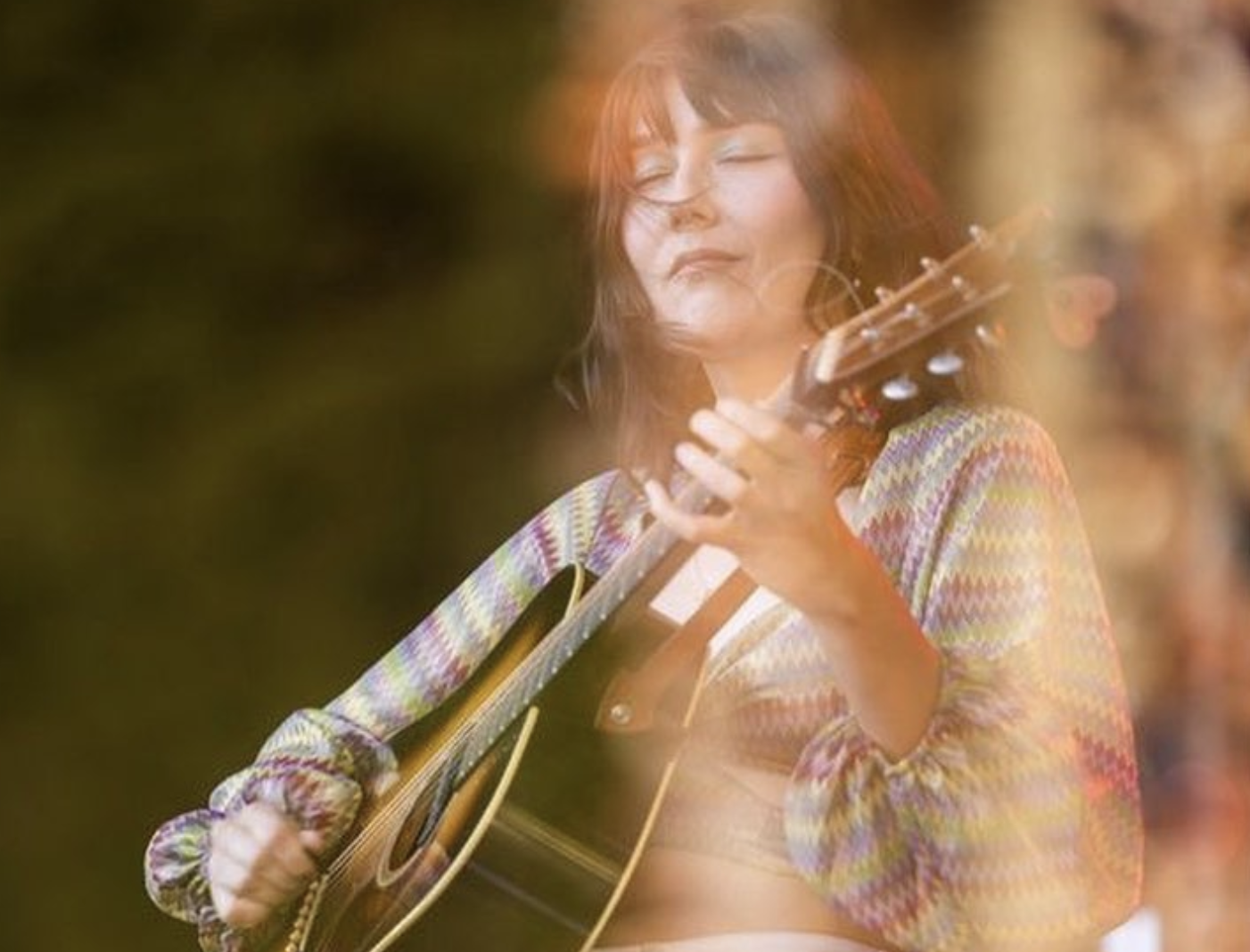Vancouver Folk Music Festival
SPOTLIGHT
Larkin Poe CONTENTS
- INTRO: A Lighter Shade of Blues
- PLAYLIST: Venom and Faith on Spotify and YouTube
- PLAYLIST: Tip o’ the Hat YouTube acoustic series
- LIVE: at the NY State Blues Festival
- ARTICLE: 10 Steps for Better Ears: Remixed by Robert Christgau

LARKIN POE: A LIGHTER SHADE OF BLUES
I first heard Larkin Poe a couple of months ago on a Facebook page called All Things Chris Whitley. The band’s Rebecca Lovell plays a decent cover of the late Whitley’s banjo tune Ball Peen Hammer.
Anyone who knows to play Whitley is worth a listen IMO. Only 45 when he died in 2005, he was a wiry, intense electric and acoustic blues player, sometimes veering into noise rock. Many of his tracks feature National steel resonator guitar, banjo and various levels of electric din and buzz.
Classically Trained Blues Sister Duo
The other reason Larkin Poe’s blues-rock-pop is of interest is that they’re performing at the Vancouver Folk Music Festival in a couple of months. I wanted to check out what the classically trained, blues sister duo of Megan and Rebecca Lovell and their band bring to the stage.
The Nashville-based group formed in 2010 growing out of Lovell Sisters which was born in 2005 and included eldest sib Jessica.
Gaining Notice
Over the last nine years the hardworking twosome have impressed with their string work (electric guitar, lap-steel, banjo, slide guitar and dobro) earning credits along the way including:
- Charting Number 1 on the Billboard blues charts for their 2018 collection Venom and Faith
- Opening for –and playing behind– Elvis Costello
- Performing at the 2014 and 2016 Glastonbury Festival, and being voted “Best Discovery of Glastonbury 2014” by the UK’s The Observer.
- Playing on Oscar-winning producer T-Bone Burnett’s 2014 collection Lost on the River: The New Basement Tapes.
YouTube Cover Song Series
They’ve also received attention for their Tip o’ the Hat YouTube series which currently features 61 cover versions of songs by everyone from Queen to Dolly Parton, Phil Collins to Ruthie Foster. It’s impressive they play that many songs. While there are some strong takes (Rollin’ and Tumblin’, Death Came A Knockin’, Jesus is Just Alright), many of them are pretty ordinary. And after a while the format of two players in an acoustically challenged room starts to challenge listeners’ attention.
Venom and Faith
The well-produced Venom and Faith CD has power and force coursing through it and is fun to listen to. The uncluttered production is welcome. However, while the vocals are nicely foregrounded, they lack the punch promised by the guitar work. The prevalence of electronic drum loops and several tub-thumping arrangements signal that while there’s a blues inspiration at work here, it’s a lighter and radio-friendly shade.
PLAYLISTS
Strong Live Performances
Judging by a number of live YouTube performances, Larkin Poe look like they put on a strong stage show. (Three songs are featured in the Live at the NY State Blues Festival playlist.)
Here’s hoping they bring that energy to Jericho Beach Park. See you there.
Festival tickets, artist schedules and information can be found on the VFMF site.
Kurated is about sharing music, stories and information about it.
Feel free to share this email column and to share music back.
It’s not likely you’re going to enjoy everything here. I’ve based this project on Robert Christgau’s article below and – in many cases– I’m sharing my discoveries. I’m enjoying the discipline of listening carefully enough to new sounds or new music by familiar artists so it that allows me to learn and write something meaningful and informative.
Stay tuned,

02 June 2019
10 STEPS FOR BETTER EARS – REMIXED
EDITORS’S NOTE: This article about the veteran music critic summarizes the spirit informing Kurated. For more about and by Robert Christgau, check out his website.

by Brad Wheeler / Globe and Mail / November, 2018
Class is in session. Self-identified as the “dean of American rock critics,” Robert Christgau was nearly 60 years old in 2001 when he contributed a 100-word squib to Dartmouth Alumni Magazine. Presented as a “10-step program for growing better ears,” the pithy instruction was aimed at his (mostly white, male) former classmates who had stopped investigating current music. It’s part of Is It Still Good to Ya?, a new collection from Duke University Press of pieces culled from Christgau’s half-century of pop coverage for The Village Voice, Spin, Rolling Stone and other venues. Speaking to The Globe and Mail from his home in New York, Christgau explained and elaborated upon his original music-listening tutorial, doing so in a manner that guides neophytes from the feel-good funk ways of James Brown to today’s hip-hop sway.
1. Don’t give up now. ”Here, I’m simply telling people who have settled into their lives that you don’t have to do that. You don’t have to decide that you’ve stopped growing or changing. I have Dartmouth classmates who are dear friends of mine who still love music, but tend to listen to stuff they listened to when they were younger. But, spurred by me I think, they do poke around a bit and get interested in, say, African music.”
2. Have a few drinks – smoke a joint, even. “Again, I’m talking to my people. ‘Loosen up, guys. I know, you’re businessmen, but you smoke a little, right?’ I don’t, by the way. I’ve barely smoked pot in the past 30 years.”
3. At the very least, lighten up, will ya? “Don’t be so uptight. This is related to ‘don’t give up now.’ I had to stretch this list out to No. 10, after all.”
4. Forget about soothing your savage beast. “For most people, music is a way to relax. By the way, you’re aware that the savage beast is a misquote? It’s actually ‘Music hath charms to soothe a savage breast.’ Same thing, though. And that it should go from breast to beast speaks very well to how people feel about rock ‘n’ roll. There’s something animal-like and bestial about it, which is not an altogether inaccurate appraisal of one of the reasons it was attractive to us in the fifties and sixties. It’s much more important to want to be enthralled, enlarged or excited by music than to be calmed by it. It’s not to say that wishing to be calmed by music isn’t a completely legitimate goal of listening to music. I do it many times. But I also want that feeling in the pit of my stomach.”
5. Repeat three times daily: The good old days are the oldest myth in the world. Or, alternatively: Nostalgia sucks. “This notion that there was this golden age, which many people associate with their time of hope before the realities of the world hemmed them in, is what sends people back to the music of their youth. People recall this lovely time, as they remember it anyway, that is evoked for them by the music they associate with that time. I’m certainly not saying I don’t do it myself. That would be inhuman. But the real bifurcation of people over 50 is hip hop. Some people have not adjusted to it. And it’s a big deal, because a substantial amount of the best music that’s been put out in the past 20 years has been hip hop.”
6. Go somewhere you think is too noisy and stay an hour. Go back. “We live in a world of noise. Many people – including, I would assume, the vast majority of my Dartmouth classmates – chose their domiciles in suburbia so that noise would be absent, lowered or muffled. But pop music is designed for a world of noise. And you have to learn to live with, absorb, filter out and hone in on that noise to be able to enjoy pop music.”
7. Grasp this truth: Musically, all Americans are part African. “There’s a reason a Southern accent is a Southern accent, right? It’s about rhythm. Willie Nelson, a country-music icon, talks about it all the time – about how the blues, in particular, is imbued into all of the music he listens to. His own phrasing is more like Billie Holiday than it is George Jones.”
8. Attend a live performance by someone you’ve never seen before. “Another way of saying, ‘Open yourself up.’ Instead of going to a show by someone who will sing your old favourites and make you feel good about the person you used to be, attend a show by someone who will make you listen.”
9. Play your favourite teenager’s favourite album three times while doing something else. Put it away. Play it again two days later and notice what you remember. “Taking the ‘favourite teenager’ part out, this is how I do my work. I put the music in the background until I either deliberately put it into the foreground, because I’ve prepared myself, or, the better case, the song is so good I want to drop what I’m doing and concentrate on that piece of music. For a piece of music to really do that to me is my best sign that there’s something there.”
10. Spend a week listening to James Brown’s Star Time. “I hate box sets, but this is a work of genius. In my opinion, in terms of changing music, what we took to be a novelty record, Papa’s Got a Brand New Bag in 1965, had a completely different rhythmic basis than any record that preceded it. It marked a change when James Brown learned what he had to do was always in the rhythm. Over the subsequent 10 years, he recorded an enormous amount of music, most of which did not make the pop charts, in which melody or hooks were very seldom what was at issue. Listening to Star Time over and over again, you begin to feel that music. My hope is, after a week, that you will then get hip hop. Because if you want to be able to hear what’s going on in music today, you have to absorb that level of rhythmic complexity. You have to start enjoying it with your body and welcome it with your ears.”





